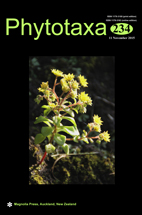Abstract
Juglans bergomensis is the name of a fossil-species belonging to Juglans sect. Cardiocaryon that is based on the basionym Juglandites bergomensis, whose type material, represented by a single fruit, is missing. However, the type locality can be indicated with certainty in the Early Pleistocene brown coal bearing sediments of Leffe, in northern Italy, which yielded several other fossil fruits with characters corresponding to the missing holotype. In the same site fruits of Juglandaceae of different fossil-species occurred. We select a specimen from a collection stored in Padua, with dimensions and sculpture most closely approaching those of the missing holotype, as neotype for the name Juglandites bergomensis, in order to fix the application of the name Juglans bergomensis. Even if the nuts of this species show “seemingly quite minor” differences from those of J. cinerea (smaller seeds, more shallow seed lobes, and generally more elongate shape), it is not convenient to use for these fossils, occurring in Eurasia, the name of the extant North American species. The use of the fossil-species name J. bergomensis, taking priority over J. tephrodes, permits to establish a clear relationship among several hundreds of Eurasian fossils assignable to sect. Cardiocaryon, and to highlight the morphological distinction from a few other fossil-species.

